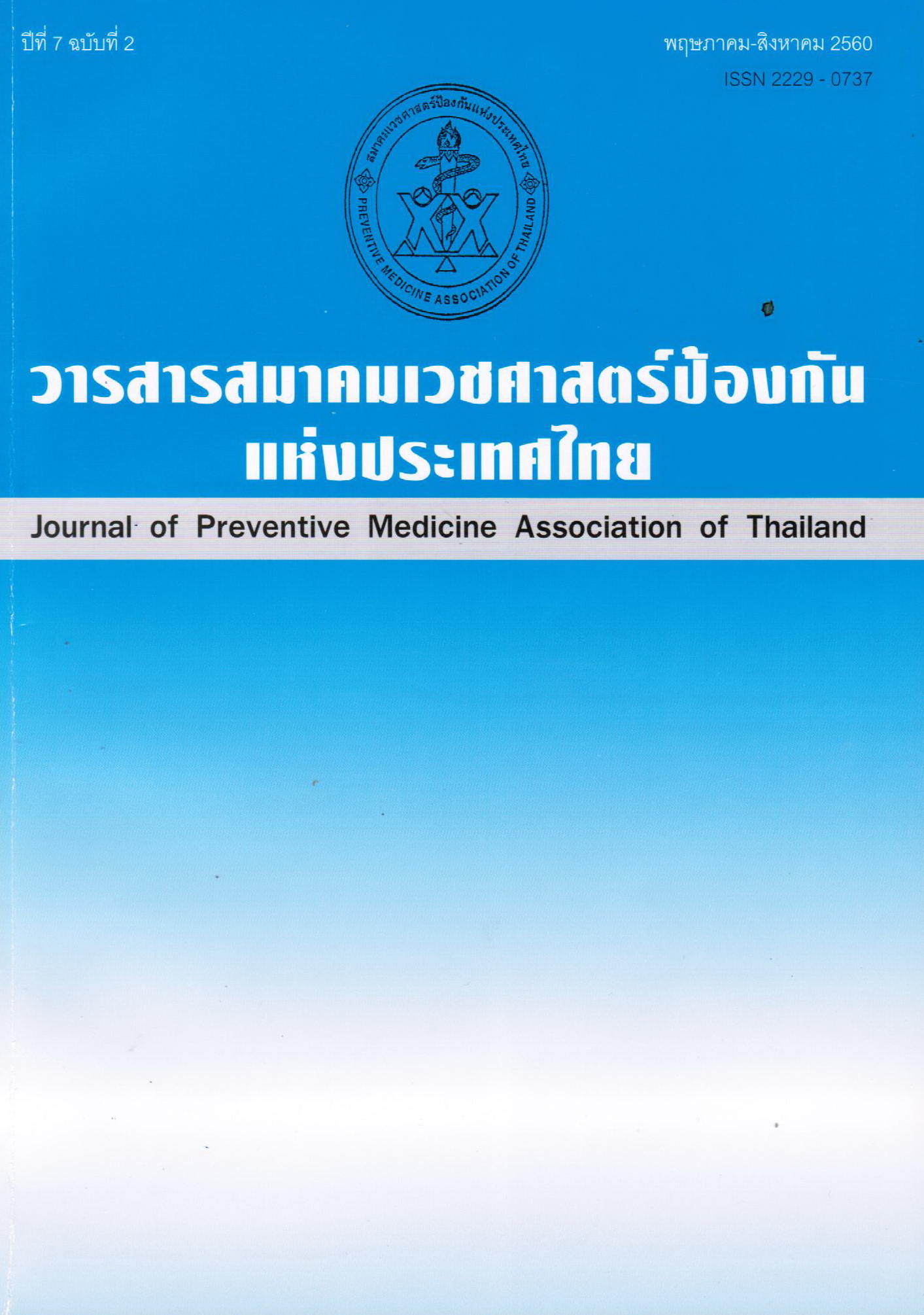อาการทางระบบทางเดินหายใจ ผิวหนัง และระบบประสาท จากภาวะมลพิษทางอากาศและกลิ่น ในพนักงาน โรงงานแปรรูปยางแผ่นรมควันแห่งหนึ่งในจังหวัดอุดรธานี
คำสำคัญ:
อาการทางระบบทางเดินหายใจ, มลพิษทางอากาศและกลิ่นบทคัดย่อ
มลพิษทางอากาศและกลิ่นเหม็นเป็นสิ่งคุกคามทางเคมีที่สำคัญที่พบเป็นประจำในโรงงานแปรรูปยางพารา ซึ่งมีสารเคมีและก๊าซหลายชนิดที่มีผลกระทบต่อสุขภาพของพนักงาน การศึกษานี้มีวัตถุประสงค์เพื่อหาความชุกของอาการทางระบบทางเดินหายใจ การระคายเคืองผิวหนัง และอาการทางระบบประสาท รวมถึงปัจจัยที่เกี่ยวข้องกับอาการดังกล่าว ใช้วิธีศึกษาแบบเชิงพรรณนา ภาคตัดขวาง ในพนักงานโรงงานแปรรูปยางแผ่นรมควันแห่งหนึ่งในจังหวัดอุดรธานีจำนวน 943 คน โดยแบ่งเป็นกลุ่มเสี่ยง และกลุ่มควบคุมในโรงงานเดียวกัน เก็บข้อมูลโดยใช้แบบสัมภาษณ์อาการผิดปกติ ตรวจร่างกายตามอวัยวะที่เกี่ยวข้อง ตรวจสมรรถภาพปอดในพนักงานกลุ่มเสี่ยงสูง และผลตรวจวัดค่าหน่วยกลิ่นของกรมควบคุมมลพิษ วิเคราะห์ข้อมูลโดยใช้สถิติ
เชิงพรรณนา ดูระดับความสัมพันธ์ด้วย odds ratio เก็บข้อมูลระหว่างเดือนมีนาคม 2560
ผลการศึกษาพบว่า ความชุกของอาการทางเดินหายใจส่วนบนและส่วนล่างเท่ากับร้อยละ 79.8 และร้อยละ 65 ส่วนอาการทางผิวหนังและระบบประสาทเท่ากับร้อยละ 38.1 และ 58.3 ตามลำดับ ความชุกของความผิดปกติจากการตรวจร่างกายที่พบ ได้แก่ เยื่อจมูกบวมแดงร้อยละ 40.1 คอแดง/ทอนซิลโต ร้อยละ 24.8 ผื่นผิวหนังร้อยละ 6.3 และตาแดง/น้ำตาไหลร้อยละ 5 พบผลสมรรถภาพปอดผิดปกติ ร้อยละ 18.2 โดยพบลักษณะปอดกำกัดการขยายตัว และหลอดลมอุดกั้นมากที่สุด (ร้อยละ 40 และ 35.6 ตามลำดับ) พบพนักงานกลุ่มเสี่ยงมีความสัมพันธ์โดยตรงกับอาการผิดปกติทางผิวหนัง [OR 1.5 (95%CI 1.09-2.07)] ความผิดปกติของจมูก [OR 1.43 (95%CI 1.05-1.96)] และความผิดปกติทางตา [OR 15.15 (95%CI 2.0-110.5)] พบผลตรวจค่าหน่วยกลิ่นที่ออกจากปล่องโรงอบยางเกินค่ามาตรฐานเทียบเคียง 20-30 เท่า และ 4 เท่าบริเวณริมรั้วโรงงาน
โดยสรุปจะเห็นว่าจากการพบความชุกของอาการทางระบบทางเดินหายใจ และความผิดปกติของอวัยวะที่เกี่ยวข้องค่อนข้างสูงในพนักงานกลุ่มเสี่ยงและค่าหน่วยกลิ่นที่เกินมาตรฐาน แสดงให้เห็นถึงปัญหาผลกระทบต่อสุขภาพพนักงาน ดังนั้นจึงควรเพิ่มมาตรการเฝ้าระวังและป้องกันทางสภาพแวดล้อมการทำงาน และสุขภาพของพนักงานในระยะยาวต่อไป
เอกสารอ้างอิง
2. รักชนก สุวรรณมณี. ความผิดปกติของระบบทางเดินหายใจและสารเคมีในบรรยากาศการทำงานของพนักงานโรงงานยางแผ่นรมควัน จังหวัดสงขลา (วิทยานิพนธ์ปริญญาวิทยาศาสตร์มหาบัณฑิต). ภาควิชาเวชศาสตร์ชุมชน สาขาวิชาอาชีวอนามัยและความปลอดภัย. สงขลา: มหาวิทยาลัยสงขลานครินทร์ ; 2552.
3. Idris NH, Kamarulzaman NH, Mohd NZ. Determination of Volatile Fatty Acids from Raw Natural Rubber Drying Activity by Thermal Desorption-Gas Chromatography. Chemical Engineering Transection, online 2012;30:175-80.
4. Danteravanich S, Yonglaoyoong S, Sridang P, Wisunthorn S, Penjamras P. Preliminary Characterization of Organic Compounds Caused Malodor of STR 20 Industry. Proc. CRRI & IRRDB Internl. Rubb. Conference; No 12-13; Siem Reap, Cambodia : 2007.
5. Miyake M, Furuuchi M, Tekasakul P, Hashimoto T, Tekasakul S, Hata M, et al. Emission Interventory Analysis on Ribbed Smoke Rubber Sheet (RSS) in Thailand as Pre-Product of Tire Imported to Japan. Proc. 6th Asian Aerosol Conference; 2009 Nov. 24-27; AP-17, Bangkok : 2009.
6. วิทชย เพชรเลียบ. การประเมินความผิดปกติของระบบทางเดินหายใจและสารเคมีก่ออันตรายของพนักงานรมควันยางแผ่นในสหกรณ์กองทุนสวนยางจังหวัดสงขลา (วิทยานิพนธ์ปริญญาวิทยาศาสตร์มหาบัณฑิต). ภาควิชาเวชศาสตร์ชุมชน สาขาวิชาอาชีวอนามัยและความปลอดภัย. สงขลา: มหาวิทยาลัยสงขลานครินทร์ ; 2551.
7. Zuskin E, Mustajbegovic J, Schachter EN, Doko-Jelinic J, Budak A. Longitudinal study of respiratory findings inrubberworkers. Am J Ind Med 1996;30:171-9.
8. Vermeulen R, Kromhout H, Bruynzeel DP, de Boer EM, Brunekreef B. Dermal exposure, handwashing, and hand dermatitis in the rubber manufacturing industry. Epidemiology. 2001;12(3):350-4.
9. Stuginski-Barbosa JI, and Speciali JG. Frequency of headache among the employees of a rubber company in the state of Sao Paulo, Brazil. Sao Paulo MedJ 2011;129(2):66-72.
10. จามร เงินชาลี. อาการทางเดินหายใจและสมรรถภาพปอดของพนักงานในโรงงานแปรรูปไม้ยางพาราแห่งหนึ่งในจังหวัดนครศรีธรรมราช (วิทยานิพนธ์ปริญญาวิทยาศาสตร์มหาบัณฑิต). ภาควิชาเวชศาสตร์ป้องกัน คณะแพทย์ศาสตร์, กรุงเทพฯ: จุฬาลงกรณ์มหาวิทยาลัย ; 2552.
11. Naldi L, Cazzaniga S, Gonçalo M, Diepgen T. Prevalence of self-reported skin complaints and avoidance of common daily life consumer products in selected European Regions. JAMA Dermatol 2014 Feb;150(2):154-63.
12. รชยา หาญธัญพงศ์. ความชุกและปัจจัยที่เกี่ยวข้องกับการเกิดผื่นผิวหนังอักเสบบริเวณมือของพนักงานทำความสะอาดในบริษัทรับจ้างทำความสะอาดแห่งหนึ่งในกรุงเทพมหานคร. (วิทยานิพนธ์ปริญญาวิทยาศาสตร์มหาบัณฑิต). ภาควิชาเวชศาสตร์ป้องกัน คณะแพทย์ศาสตร์, กรุงเทพฯ: จุฬาลงกรณ์มหาวิทยาลัย; 2551.
13. Bauchau V, and Durham SR. Prevalence and rate of diagnosis of allergic rhinitis in Europe. Eur Respir J 2004;24:758-64.
14. Nathan RA, Meltzer EO, Derebery J, Campbell UB, Stang PE, Corrao MA, et al. The prevalence of nasal symptoms attributed to allergies in the United States: findings from the burden of rhinitis in an America survey. Allergy Asthma Proc 2008;29:600-8.
15. Zhang Y, and Zhang L. Prevalence of allergic rhinitis in china. Allergy Asthma Immunol Res 2014;6:105-13.
16. Bunnag C. A survey of allergic rhinitis in Thai. Siriraj Hosp Gaz 1995;47:1027-31.
17. Ayse S., Nejat D., Levent K. Evaluation of Respiratory Symptoms in Workers of a Rubber Factory. Eur J Gen Med 2011;8(4):302-7.
18. Attarchi M, Dehghan F, Afrasyabi M. Combined effect of cigarette smoking and occupational exposures on lung function: a cross-sectional study of rubber industry workers. Workplace Health Saf 2013;61(5):213-20.
ดาวน์โหลด
เผยแพร่แล้ว
รูปแบบการอ้างอิง
ฉบับ
ประเภทบทความ
สัญญาอนุญาต
บทความที่ลงพิมพ์ในวารสารเวชศาสตร์ป้องกันแห่งประเทศไทย ถือเป็นผลงานวิชาการ งานวิจัย วิเคราะห์ วิจารณ์ ตลอดจนเป็นความเห็นส่วนตัวของผู้นิพนธ์ กองบรรณาธิการไม่จำเป็นต้องเห็นด้วยเสมอไป และผู้นิพนธ์จะต้องรับผิดชอบต่อบทความของตนเอง






